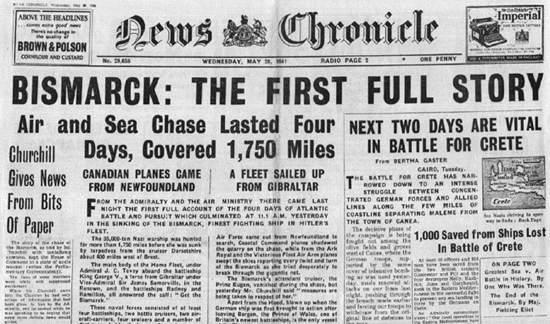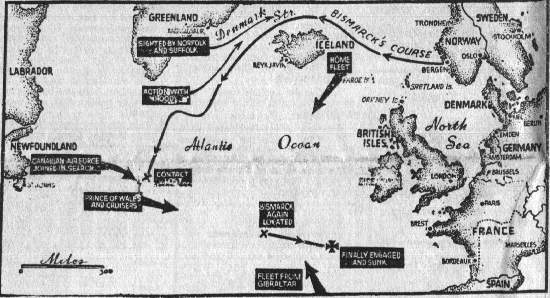 |
| Home Intro Technical History Crew Models Gallery Kriegsmarine Archives More Forum Español UPDATES |

Air and Sea Chase Lasted Four Days, Covered 1,750 Miles
A FLEET SAILED UP FROM GIBRALTAR
FROM THE ADMIRALTY AND THE AIR MINISTRY THERE CAME LAST NIGHT THE FIRST FULL ACCOUNT OF THE FOUR DAYS OF ATLANTIC BATTLE AND PURSUIT WHICH CULMINATED AT 11.1 A.M. YESTERDAY IN THE SINKING OF THE BISMARCK, FINEST FIGHTING SHIP IN HITLER'S FLEET.
The 35,000-ton Nazi warship was hunted for more than 1.750 miles before she was sunk by torpedoes from the cruiser Dorsetshire about 400 miles west of Brest.
The main body of the Home Fleet, under Admiral J. C. Tovey aboard the battleship King George V., a force from Gibraltar under Vice-Admiral Sir James Somerville, in the Renown, and the battleships Rodney and Ramillies, all answered the call: "Get the Bismarck."
These naval forces consisted of at least four battleships, two battle cruisers, two air-craft-carriers, four cruisers and a number of destroyers led by the famous Cossack.
In addition, machines of the Canadian
Air Force came out from Newfoundland to search, Coastal Command planes shadowed the quarry on the chase, while from the Ark Royal and the Victorious Fleet Air Arm planes swept the skies reporting every twist and turn of the Bismarck as she tried desperately to break through the gigantic net.
The Bismarck's attendant cruiser, the Prinz Eugen, vanished during the chase, but yesterday Mr. Churchill said "measures are being taken in respect of her."
Apart from the Hood, blown up when the German ship was first brought to action after leaving Bergen, the Prince of Wales, one of Britain's newest battleships, is the only vessel of the Fleet to suffer damage.
This is the Admiralty communiqué:

Air reconnaissance by Coastal Command aircraft revealed that a German battleship and cruiser, which they had previously located in the Norwegian port of Bergen, had sailed. Certain dispositions were therefore ordered, and as a result H.M.S. Norfolk (Captain A. J. L. Phillips, R.N.), wearing the flag of Rear Admiral W. F. Wake-Walker C.B., O.B.E., and H.M.S. Suffolk (Captain R. M. Ellis R.N.), were ordered to take up a position in the Denmark Straits.
Shadowed All Through Night
On the evening of May 23 Admiral Wake-Walker reported sighting an enemy force of one battleship and one cruiser proceeding at high speed to the south westward. Visibility in the Denmark Strait was bad and extremely variable. The range of the enemy was only six miles when he was at first sighted, and storms of snow and sleet and patches of mist at times reduced the visibility to one mile. Despite the difficulties of visibility H.M.S. Norfolk and H.M.S. Suffolk shadowed the enemy successfully throughout the night. Meanwhile other units of the Royal Navy were taking up dispositions at high speed with a view to intercepting the enemy and bringing him to action with our heavy forces.
Set On Fire in First Clash
Early in the morning of May 24 H.M.S. Hood (Captain R. Kerr, C.B.E., R.N.), wearing the flag of Vice-Admiral L. E. Holland, C.B., with the H.M.S. Prince of Wales (Captain J. C. Leach, M.V.O., R.N.) in company, made contact with the enemy. Action was immediately joined. During the ensuing engagement Bismarck received damage and was at one time seen to be on fire. H.M.S. Hood, as has already been announced, received a hit in the magazine and blew up. H.M.S. Prince of Wales sustained slight damage. The chase was continued on a south westerly course with H.M.S. Norfolk and H.M.S. Suffolk, shadowing the enemy and maintaining contact despite all his efforts to shake off the pursuit. It appeared at this time that the enemy's speed had been slightly reduced, and reconnaissance aircraft of the Coastal Command reported that she was leaving a wake of oil.
Prince of Wales In Action Again
On the evening of May 24, H.M.S. Prince of Wales again made contact with the enemy and action was joined for a short time. The German ships at once turned away to the westward and then swung round on to a southerly course, with our forces still in pursuit. Other of our naval forces were now approaching the enemy and during the night naval torpedo bombing aircraft from H.M.S. Victorious (Captain H. C. Bowell, R.N.) delivered a torpedo attack on the enemy from a considerable distance, and one torpedo was seen to hit the Bismarck. H.M.S. Norfolk, H.M.S. Suffolk and H.M.S. Prince of Wales continued to shadow the enemy successfully until shortly after 3 a.m. on May 25. Touch with the [At this point the article continues on Page 3, Col 4 under the title: "Crippled Bismarck Fought Destroyers Before Torpedo Sent Her Down"]
enemy was now lost in low visibility. The enemy was then approximately 350 miles south-southeast of the southern point of Greenland. Searching dispositions were at once taken up by other units of the Royal Navy. The main body of the Home Fleet, under the command of Admiral J. C. Tovey, K.C.B., D.S.O., with his Flag in H.M.S. King George the Fifth (Captain W. R. Patterson, C.V.O., R.N.), was steaming at high speed in a south-westerly direction from northern waters. Another force under the command of Vice-Admiral Sir James F. Somerville, K.C.B., D.S.O., with his Flag flying in H.M.S. Renown (Captain R. R. McGrigor, R.N.) was steaming north-westwards at high speed from Gibraltar. H.M.S. Rodney (Captain F. H. G. Dalrymple Hamilton, R.N.), H.M.S. Ramillies (Captain A. D. Read, R.N.), who were escorting convoys in the North Atlantic, proceeded to move in the direction of the enemy.
Plane Finds Bismarck Again
Extensive air searches were organised by Coastal Command and by the Royal Canadian Air Force stationed in Newfoundland. It was not until about 10.30 a.m on May 26 that the enemy was again located. At that time the Bismarck was sighted by a Catalina aircraft of Coastal Command in a position about 550 miles west of Land's End. This aircraft was attacked and as a result lost touch with the enemy battleship half an hour later, but at 11.15 a.m. the Bismarck was sighted by naval aircraft operating from H.M.S. Ark Royal (Captain L. E. H. Maund, R.N.). Only the battleship Bismarck was seen, and she was then steering an easterly course. At this time H.M.S. King George the Fifth and H.M.S. Rodney were approaching the area, but were not yet sufficiently close to bring the enemy to action. As soon as Bismarck was sighted by Ark Royal's aircraft Admiral Sir James Somerville detached the cruiser H.M.S. Sheffield (Captain C. A. A. Larcom, R.N.) to make contact with and shadow the Bismarck. During the afternoon a striking force of naval aircraft was dispatched from H.M.S. Ark Royal to attack with torpedoes, but this proved unsuccessful. Shortly after 5.30 p.m. H.M.S. Sheffield made contact with the Bismarck and proceeded to shadow her. Within 20 minutes another striking force of naval aircraft was flown off by H.M.S. Ark Royal.
Destroyers Go Into Action
This force attacked successfully, and one torpedo was seen to hit the Bismarck amidships. A second hit was obtained by a torpedo on the starboard quarter of the German battleship. It was subsequently reported that on being hit during this attack, the Bismarck made two complete circles, and that her speed was again reduced. During the evening some of our destroyers of the Tribal class, under the command of Captain P. L. Vian, D.S.O., R.N., in H.M.S. Cossack, made contact soon after 11 p.m. Between 1.20 a.m. and 1.15 a.m. on May 27 the Bismarck was attacked by torpedoes by H.M.S. Zulu (Commander H. R. Graham D.S.O., R.N.), H.M.S. Maori (Commander H. D. Armstrong, D.S.C., R.N.), and H.M.S. Cossack. H.M.S. Cossack and H.M.S. Maori each hit with one torpedo. After H.M.S. Maori's attack it was reported that there was a fire on the forecastle of the German battleship. One hour after these attacks by our destroyers it was reported that the Bismarck appeared to be stopped. She was then about 400 miles due west of Brest, and had been pursued by our forces for more than 1,750 miles. It was subsequently reported that the Bismarck was again under way, and had made good about eight miles in one hour, and that she was still capable of heavy and accurate gunfire. At daylight on May 27 another striking force of naval aircraft was dispatched from H.M.S. Ark Royal, but this had to be cancelled owing to low visibility.
Cruiser Gave the Coup de Grace
Shortly after daylight the Bismarck engaged our destroyers by gunfire. H.M.S. Norfolk was in action with the Bismarck almost immediately afterwards and very soon the Bismarck was being engaged by our heavy ships. Details of this phase of the action have not yet been received. It is known, however, that H.M.S. Dorsetshire, Capt. B. C. S. Martin, R.N., was ordered to sink the Bismarck with torpedoes. Bismarck sank at 11.01 this morning. So far as is known at present (ends the communique) the only damage sustained by H.M. ships other than H.M.S. Hood is the slight damage to H.M.S. Prince of Wales already referred to.

| Home Guestbook Quiz Glossary Help us Weights & Measures Video Credits Links Contact |
